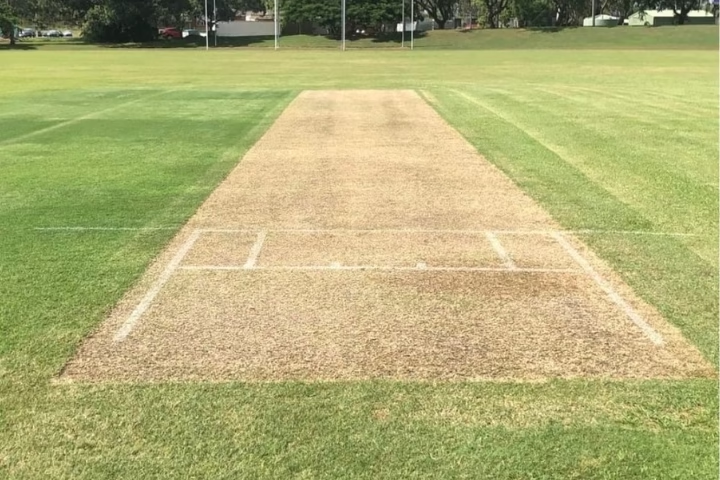Cricket Pitch Length: Dimensions, Measurements, and Types
By Smrati Khare 08 Nov 2024, 08:27 IST


The cricket pitch is one of the most crucial components of a cricket field. Its precise dimensions are vital to ensure fair gameplay and consistency across all levels of the sport. While the size of a cricket ground can vary, the cricket pitch has specific measurements that remain consistent globally. In this article, we’ll delve into the dimensions, types, and unique characteristics of a cricket pitch, providing an insightful look into the heart of the cricket field.
Understanding the Cricket Pitch
The cricket pitch is the central, rectangular area on a cricket field where bowlers bowl and batters play. This 22-yard (20.12 meters) stretch connects the two wickets and is a focal point of every cricket game. Both the bowler and batsman engage here, making it the most action-packed area on the field. A cricket pitch can vary in its surface composition, influencing gameplay and the way the ball behaves.
Cricket Pitch Dimensions
A cricket pitch is a well-defined rectangle that measures 22 yards (20.12 meters) in length from one wicket to the other and 10 feet (3.05 meters) in width. These dimensions have been a standard for decades, adhering to measurements from the British imperial system. Cricket’s colonial roots have ensured that pitch measurements remain traditional, with the 22-yard measurement, also known as “one chain” in the imperial system, serving as the baseline.
Key Dimensions:
| Length Of The Wicket To Wicket | 22 Yards (20.12 meters) or 66 feet |
| Width Of The Pitch | 10 Feet (3.05 meters) |
| Crease Length | 4 Feet (1.22 meters) |
Why 22 Yards?
The 22-yard pitch measurement comes from traditional British measurements, where one “chain” is exactly 22 yards long. This standard has been upheld as it suits the playing needs of cricket effectively. It allows enough space for bowlers to gain momentum and deliver their ball, and for batsmen to adjust and make a successful run.
Breaking Down the Cricket Pitch Areas
Wickets: Each end of the pitch features a set of three stumps, topped by two bails, collectively called a wicket. This setup is where bowlers aim and batsmen defend.
Creases:
Bowling crease: Where the stumps are placed. Bowlers must stay behind this line to deliver a legal delivery.
Popping crease: Positioned 4 feet (1.22 meters) in front of the bowling crease, it marks the safe zone for batsmen.
Return crease: Marked perpendicular to the other creases, the return crease indicates where bowlers’ feet must stay to avoid delivering a “no-ball.”
Other Notable Pitch Areas: Around the pitch, the grass is usually cut shorter than the outfield, which speeds up the ball’s movement.
Measuring the Cricket Pitch in Other Units
Cricket pitches are measured in various units, from feet to meters and yards. Here’s a quick reference:
| Dimensions | Measurement |
| In Meters |
20.13 meters From Wicket To Wicket, 3.05 meters wide.
|
| In Feet | 66 Feet in Length 10 feet in width |
| In Steps |
An adult’s stride of approximately 10 meters will mean 26 steps for the full pitch length.
|
Types of Cricket Pitches
Different pitches impact the gameplay by influencing how the ball behaves. Broadly, pitches can be classified based on their conditions:
- Green Pitches: These have a layer of live grass, which helps the ball seam and swing. Such pitches benefit fast bowlers.
- Dry or Dusty Pitches: Commonly found in subcontinental regions, these pitches support spin bowlers by creating more turn.
- Hard Pitches: Known for their even bounce, these pitches are batter-friendly and often seen in places with warmer climates.
Factors Influencing the Cricket Pitch
The cricket pitch surface plays a crucial role in determining how a match progresses. Weather, grass type, soil composition, and maintenance influence how pitches behave during a game. Pitches can vary greatly across different countries, with conditions favoring either fast or spin bowlers.
Weather: Hot climates dry out the pitch, making it crumbly and suitable for spinners.
Soil and Grass Type: Clay-heavy soil retains moisture, favoring swing and seam bowling.
Maintenance: Regular rolling and watering affect the bounce and consistency of the pitch surface.
Pitch Length Variations for Junior Cricket
Junior cricket often has adjusted pitch lengths to suit younger players:
| Age | Yards |
| Under-15 | 22 Yards ( Standard Adult Pitch) |
| Under-13 | 21 Yards |
| Under-11 | 19 Yards |
| Under-9 | 16 Yards |
These adjustments help younger players participate without being overwhelmed by the full-sized pitch.
The cricket pitch length is fundamental to the game, influencing gameplay and outcomes. Its 22-yard measurement, rooted in tradition, remains a consistent feature globally. By understanding the dimensions and variations, cricket fans and players alike gain insight into how subtle aspects like pitch type and maintenance affect this beloved game.
Stay updated with all the cricketing action, follow Cricadium on WhatsApp, Facebook, Twitter, Telegram, and Instagram
You might also like
Recommended to you












